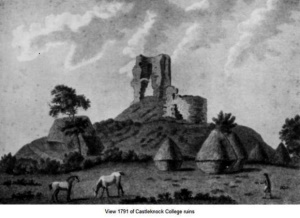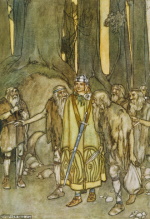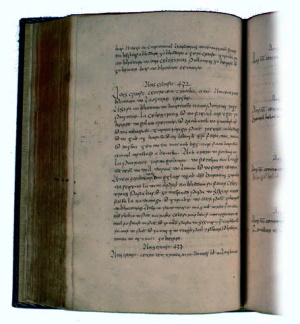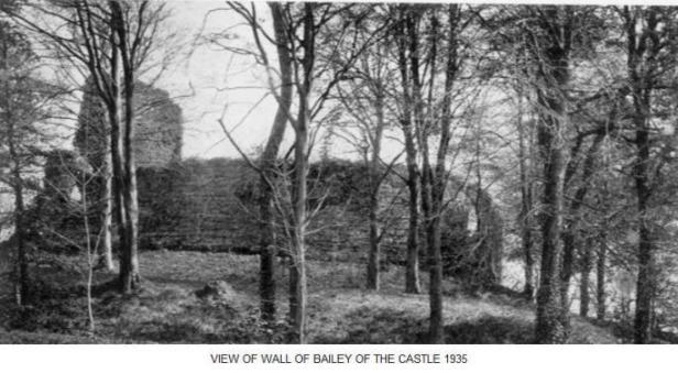Irish Ghost Story: The White Lady of Castleknock

The sites on which the remains of Ireland’s many medieval strongholds can be seen today, are often built on the location of former forts. In a number of cases the existence of these former fortresses are only remembered in local folklore. Many excavations have given substance to this local knowledge, when it is revealed that later castles are built on previous Iron and Bronze Age forts. This is perhaps not so surprising given they are located on naturally strategic points from which to control the surrounding land. So many sensible historians and archaeologists are wise to listen carefully to the verbal tradition of stories handed down from generation to generation. Because within these tales, embellished over the years, there is often more than a grain of truth.

One such place is Castleknock Castle in Ireland. A Norman castle, the ruins of which are in the grounds of St. Vincent's College to the west of the city of Dublin (Irish: Baile Átha Cliath). Built towards the end of the twelfth century on a mound which is said to have formerly been the site of an ancient royal residence, as well as a tumulus. Within the College grounds is another mound surmounted by a tower erected in the eighteenth century; this mound has traditionally been said to be the burial place of Cumhal, father of Fionn Mac Cumhail. These two mounds are now generally considered to be the termination of the line of hills, known as the Eiscir Riada, which figure so largely in early Irish history.

Under the name Cnucha, this place is mentioned several times in the Annals of the Four Masters (Irish: Annála na gCeithre Máistrí). These are chronicles of medieval Irish history compiled between 1632 and 1636, but are mainly a compilation of earlier annals. It is also mentioned in Geoffrey Keating's History of Ireland, and in several of the older Annals. They make reference to pre-Christian times and the earlier ages of Christianity. During the Milesian era, a time when an ancient race of gaels settled in Ireland, Conmhael of the race of Ebher defeated the descendants of Eremhon. It is later described as the dumha of the sons of Eremhon, suggesting that it was a place of note and used as a residence. Conn of the Hundred Battles resided here; Feilim son of Conn is described as the brave King of Cnucha; a famous battle was fought here in the second century. All these events suggest the origin of the name Cnucha.
The old legends surrounding Castleknock and the hill on which the remains of the castle now stand were bolstered during excavationswhich which were reported to have taken place a number of years ago. According to some accounts in 1861 workmen accidently uncovered a pagan grave (Cromlech) when digging within the castle. The description of the Cromlech fits with the burial place of people of importance in ancient times. The workmen uncovered and broke open a large flat stone. On detaching a portion, they found a grave and human skeleton beneath. The head and larger bones were said to be in good condition alongside small heaps of dry, white dust. The men had no expertise or understanding of the historical nature of their discovery and placed the bones to one side. It was not till the grave was filled up and the archaeolgical importance of the site was understood, by which time it was too late to remedy the damage caused to the integrity of the site.

Castlenock Castle is now said to be haunted by a spirit known as “The White Lady of Castleknock”. Legend has it that this ghost has nothing to do with the ancient remains found in the Cromlech. It is to do with the later story of the suicide of Eibhleen O'Brinn. The time of the story is said to be the sixteenth or possibly fourteenth century. If the incident happened in the fourteenth century then the villain is thought by some to be identified as John Tyrrell, brother of Richard Tyrrell the Sixth Baron. John was noted for being a violent and unpleasant man. When the Baron was away he terrorised the neighbouring families and despite attempts to bring him to count for his actions would continue to do evil. One such incident inviolved O’Brinn (O'Byrne), a Wicklow Chief, who lived south of Chapelizod near Ballyfermot Hill. John Tyrrell abducted the Chief’s beautiful daughter Eibhleen O’Brinn and imprisoned her in Castleknock Castle.

At the dead of night, hearing footsteps approaching the room in which she was confined, she feared the worst. To avoid this fate, she opened a vein with her breast-pin, and bled to death. In the meantime her father had gathered his friends and followers and attacked the castle in an attempt to free his daughter. John Tyrrell was slain fighting but all too late to save Eibhleen. The story of her death was told from generation to generation. It was the popular belief that at midnight the ghostly figure of Eibhleen, robed in white, could be seen moving slowly round the Castle walls and wailing in sorrow at her untimely end. She was known as the "White Lady of Castleknock." In The Nation, which was an Irish nationalist weekly newspaper published in the 19th century, a poem was written anonymously that commemorated the event.
When distant chimes sound midnight hour,
The spirit pure is seen
And moving round the lonely tower.
Looks bright as moonlight beam.
And as the moonbeams tint the walls,
And light the turret's crest,
Twas hence, she says, 'my spirit fled,
Tis here my bones find rest.
And here I wander, year by year,
For such my lot has been,
But soon at end my penance drear,
I'll rest in joy unseen.
Further information: CASTLEKNOCK COLLEGE UNION: Castleknock Castle: its Owners, 1935 Centenary Record https://www.knockunion.ie/news/castleknock-castle-its-owners-354
Content type:
- Irish
Language:
- English





